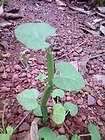Note: This is a project under development. The articles on this wiki are just being initiated and broadly incomplete. You can Help creating new pages.
Cissus quadrangula
Cissus quadrangularis is a deciduous, succulent, climbing plant producing stems from 1 - 15 metres long from a tuberous rootstock. The stems either scramble over the ground or climb into the surrounding vegetation, attaching themselves by means of tendrils.
Contents
[hide]- 1 Uses
- 2 Parts Used
- 3 Chemical Composition
- 4 Common names
- 5 Properties
- 6 Habit
- 7 Identification
- 8 List of Ayurvedic medicine in which the herb is used
- 9 Where to get the saplings
- 10 Mode of Propagation
- 11 How to plant/cultivate
- 12 Commonly seen growing in areas
- 13 Photo Gallery
- 14 References
- 15 External Links
Uses
Asthma, Amenorrhoea, Haemorrhoids, Broken bones, Rheumatic joints, Saddle sores, Indigestion.
Parts Used
Chemical Composition
Two new iridoids 6-O-[2,3-dimethoxy]-trans-cinnamoyl catalpol and 6-O-meta-methoxy-benzoyl catalpol along with a known iridoid picroside, two stilbenes quadrangularin A and pallidol, Quercitin, Quercitrin, Beta-sitosterol and Beta-sitosterol glycoside.[1]
Common names
| Language | Common name |
|---|---|
| Kannada | |
| Hindi | |
| Malayalam | |
| Tamil | |
| Telugu | |
| Marathi | |
| Gujarathi | |
| Punjabi | |
| Kashmiri | |
| Sanskrit | |
| English |
Properties
Reference: Dravya - Substance, Rasa - Taste, Guna - Qualities, Veerya - Potency, Vipaka - Post-digesion effect, Karma - Pharmacological activity, Prabhava - Therepeutics.
Dravya
Rasa
Guna
Veerya
Vipaka
Karma
Prabhava
Habit
Identification
Leaf
| Kind | Shape | Feature |
|---|---|---|
Flower
| Type | Size | Color and composition | Stamen | More information |
|---|---|---|---|---|
| {{{5}}} |
Fruit
| Type | Size | Mass | Appearance | Seeds | More information |
|---|---|---|---|---|---|
Other features
List of Ayurvedic medicine in which the herb is used
Where to get the saplings
Mode of Propagation
How to plant/cultivate
A plant of drier to arid regions, mainly in the lowland tropics and frost-free subtropics, though it can also be found at elevations over 2,000 metres.[3]
Commonly seen growing in areas
Thicket, Acacia woodland, Grassland with scattered Combretum, Termite mounds, Coastal forest edges.
Photo Gallery
References
- Jump up ↑ [Chemistry]
- Jump up ↑ Kappatagudda - A Repertoire of Medicianal Plants of Gadag by Yashpal Kshirasagar and Sonal Vrishni
- Jump up ↑ Cultivation
External Links
- Ayurvedic Herbs known to be helpful to treat Asthma
- Ayurvedic Herbs known to be helpful to treat Amenorrhoea
- Ayurvedic Herbs known to be helpful to treat Haemorrhoids
- Ayurvedic Herbs known to be helpful to treat Broken bones
- Ayurvedic Herbs known to be helpful to treat Rheumatic joints
- Ayurvedic Herbs known to be helpful to treat Saddle sores
- Ayurvedic Herbs known to be helpful to treat Indigestion
- Herbs with Young green stems used in medicine
- Herbs with Fruit used in medicine
- Habit - Deciduous climber
- Index of Plants which can be propagated by Seeds
- Herbs that are commonly seen in the region of Thicket
- Herbs that are commonly seen in the region of Acacia woodland
- Herbs that are commonly seen in the region of Grassland with scattered Combretum
- Herbs that are commonly seen in the region of Termite mounds
- Herbs that are commonly seen in the region of Coastal forest edges
- Herbs
- Pages without herbs images



